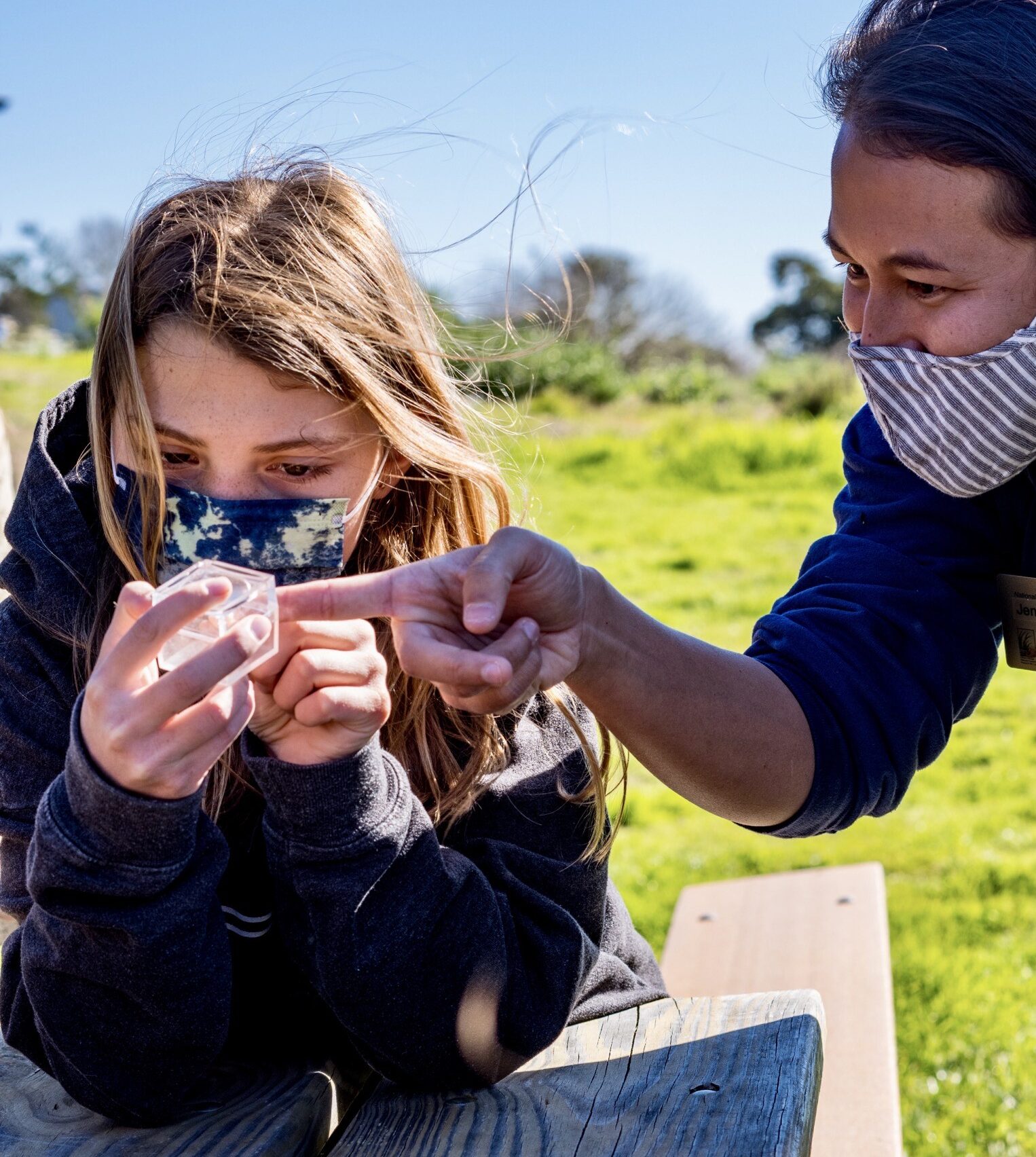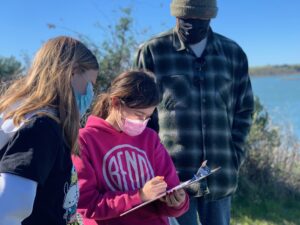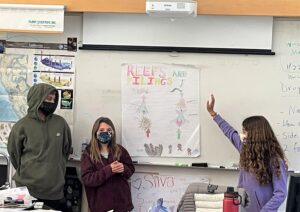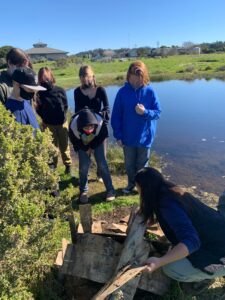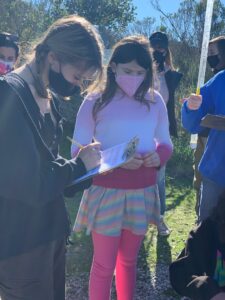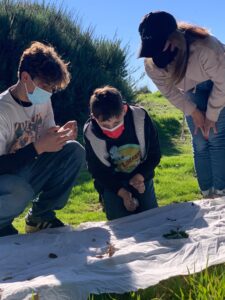 On a clear, sunny morning last week, curious students explored the flora and fauna of the Elkhorn Slough National Estuarine Research Reserve, investigating invertebrate specimens, water, air and soils tests, and recording observations in nature journals.
On a clear, sunny morning last week, curious students explored the flora and fauna of the Elkhorn Slough National Estuarine Research Reserve, investigating invertebrate specimens, water, air and soils tests, and recording observations in nature journals.
Mount Madonna School (MMS) fifth and ninth grade students are “science buddies,” and throughout the school year explore different ocean ecosystems as part of their weekly class time together. Recently, in buddy pairs, students created and presented a food web for the different ocean habitats.
At Elkhorn, one activity that captured the students’ interest was identifying invertebrates from an oak tree “shake,” using small, see-through boxes with magnifiers on top to carefully examine different live specimens up close.
with magnifiers on top to carefully examine different live specimens up close.
 “We looked at the number of legs, colors, and other distinguishing features,” said fifth grader Amelie Thams. Students recorded their findings on bar graphs, and reported finding many spiders, worms, insects and even a bright green millipede.
“We looked at the number of legs, colors, and other distinguishing features,” said fifth grader Amelie Thams. Students recorded their findings on bar graphs, and reported finding many spiders, worms, insects and even a bright green millipede.
“One of my favorite activities at Elkhorn Slough was to shake bugs out of trees and look at them up close and magnified,” commented ninth grader Cisco Rothman-Salado.
Fifth grader River Brinton said he and ninth grade buddy Luke Connor tested the pH of a slough water sample.
“We tossed a bucket tied to a rope into the water to collect the water,” said Brinton. “Working with my buddy was helpful, because you really needed some brawn to pull that bucket up!”
During a group hike along a trail, students noticed numbered bird “boxes” that had been posted in several locations.
“Staff at the slough check these to track how healthy different bird populations are,” explained Thams. “They notice what kinds of birds use the boxes, and how many of the birds there are.”
Students also explored the flora and fauna around a restored vernal pond. The pond was restored by slough staff to help salamanders and tree frogs and other animals as vernal ponds are disappearing due to underground water pumping for agriculture.
These studies are part of fifth grade’s broader environmental project on sea lions (read more about the students’ project here) The Elkhorn Slough and the slough reserve is an important habitat for sea lion births in the Monterey Bay. This field study ties in well with ninth grade’s year-long marine biology curriculum.
 “MMS students study ocean ecosystems and this exploration allows them to study, in the field, one of our local, important ocean ecosystems,” said science teacher Nicole Silva Culbertson. “Students have studied energy and biomass pyramids, complex food webs and how important the slough is to the health of our local environment. The ninth graders can share what they have learned to help support the fifth graders with their sea lion environmental project.”
“MMS students study ocean ecosystems and this exploration allows them to study, in the field, one of our local, important ocean ecosystems,” said science teacher Nicole Silva Culbertson. “Students have studied energy and biomass pyramids, complex food webs and how important the slough is to the health of our local environment. The ninth graders can share what they have learned to help support the fifth graders with their sea lion environmental project.”
As part of the hands-on learning at Elkhorn, students were also able to use scientific tools to measure pH, salinity, water, air and soil temperature, turbidity, air and soil temperature. Their data will be uploaded by Elkhorn Slough Reserve staff into The GLOBE Program, a worldwide data system that tracks water quality around the world.
“I had a great time at the Elkhorn Slough with our little buddies,” said ninth grade student Tej D’Costa-Hemp. “It was very hands-on and made you think about all the factors in an ecosystem. We learned new things, like how they take in data for everything in the area and how to test water clarity, temperature and wind levels. Overall we each took something away from this experience that taught us about nature and science.”
was very hands-on and made you think about all the factors in an ecosystem. We learned new things, like how they take in data for everything in the area and how to test water clarity, temperature and wind levels. Overall we each took something away from this experience that taught us about nature and science.”
Fifth grade teacher Jessica Cambell said the pairing up the elementary and high school students was beneficial for all involved.
“We do this field trip with both groups of students together because the ninth graders are able to be teacher-mentors and guide their fifth-grade buddies in the more complex scientific investigations,” said Cambell, “allowing the younger students to glean more from the experience and better understand what they are learning, and it’s also just fun!”
 “My big buddy is Lucy [Harris], commented fifth grader Molly Pizlo. “She did help me to understand some of the things that I haven’t learned yet.”
“My big buddy is Lucy [Harris], commented fifth grader Molly Pizlo. “She did help me to understand some of the things that I haven’t learned yet.”
“I very much enjoyed getting to know my buddy more during the field trip,” said ninth grade student Ezze Farrazaino. “We found out that we actually have a lot in common and like a lot of similar things. At first it felt a little awkward, but as the day progressed, I felt more comfortable talking to my buddy and hanging out with her, and before long we were quizzing each other about a book series we both love. I also had a lot of fun doing the tests that real scientists get to do, as I would like to be a scientist, so it was great getting some hands-on experience.”
Field studies allow students to make connections between the broader concepts they are reading and learning about in the classroom and impacts closer to home.
“This tangible, sensory experience,” noted Silva Culbertson, “helps students to understand on a deeper level the importance of our local ocean ecosystems.”
###
Contact: Leigh Ann Clifton, director of marketing & communications,
Nestled among the redwoods on 375 acres, Mount Madonna School (MMS) is a diverse learning community dedicated to creative, intellectual, and ethical growth. MMS supports its students in becoming caring, self-aware, discerning and articulate individuals; and believe a fulfilling life includes personal accomplishments, meaningful relationships and service to society. The CAIS and WASC accredited program emphasizes academic excellence, creative self-expression and positive character development. Located on Summit Road between Gilroy and Watsonville. Founded in 1979.

